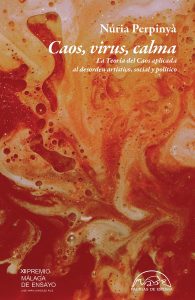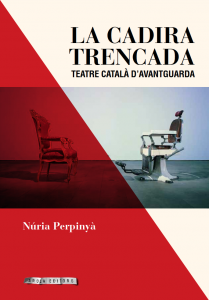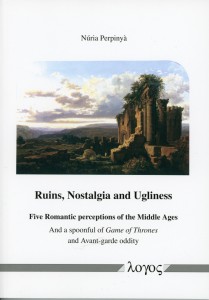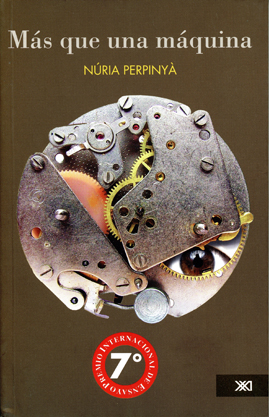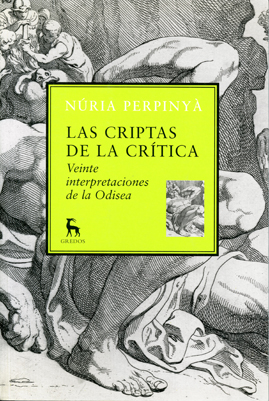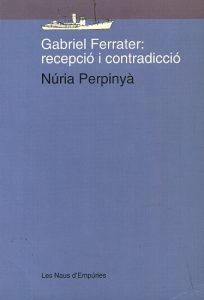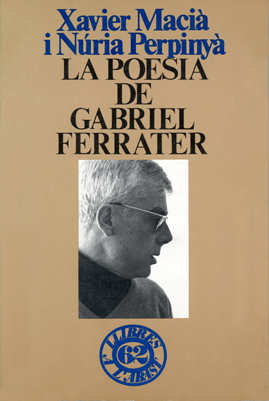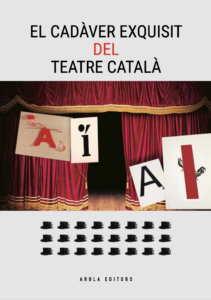Chaos, virus, calm. Chaos Theory applied to artistic, political and social disorders (2021) analyzes the similarities between various chaotic phenomena: avant-garde art, pandemics, political scenes, and the orbits of some stars.
This work not only deserves attention for the effort to take Chaos theory beyond science and show its usefulness in analyzing literature and art, but also conveys a key message: the exaggeration of Relativism leads to the postfalsehood (…) Authors like N√ļria Perpiny√† show the benefits of a rigorous rapprochement between Science and Humanities.
DUR√ĀN, Xavier. √ćnsula. 917. May 2023.
When chaos is worth millions of dollars in art, but not in politics.
OLIVA, José. Agencia EFE. 27 June 2021.
N√ļria Perpiny√†:¬†“Chaos is another kind of order” The novelist and thinker finds balance where confusion reigns, either quantum physics, virus or art. She realises it in an essay, recent Malaga Prize.¬†
BURDEUS, Joan. Quadern. El País. April 8th 2021.
Chaos is what defines our natural order.
IGLESIA, Anna Maria. The Objective. March 15th 2021.
Physics explains Post-Truth, according to the Malaga Essay Prize.
La opinión. December 16th 2020
The choice between saving lives or saving the economy is a false dilemma.
BUJALANCE, Pablo. Malaga hoy. December 17th, 2020 [PDF]
La cadira trencada. Teatre catal√† d’avantguarda / The broken chair. Catalan Avant-Garde Theater¬†(2018)¬†typifies the features the Avant-Garde and the different tendencies of Modern Theater (political, absurd, experimental, feminist, audiovisual, meta-theater, etc.). The work analyzes one hundred years of international theater renovations, and their effects in Catalonian plays.¬†[The book is avalaible here]
Versatility, multiple curiosity and expansive and accurate knowledge are characteristic of Perpiny√†’s creative behavior, as were the spirit and the desires of the Classical Avant-Garde.
PONS, Pere Antoni coord. “La cadira trencada. Teatre catalaŐÄ d‚Äôavantguarda, de NuŐĀria PerpinyaŐÄ”. El Temps de les Arts. El Temps. October 2019.¬† [PDF]¬†¬†
The Homeric Odysseus compared to James Joyce’s Uliysses.¬† Seminar of the Center of Contemporary Culture of Barcelona (CCCB). BARCELONA. January 16th 26th, 30th 2019. Coordinator:¬†Ra√ľl Garrigasait.¬†¬†¬† Here you can listen to the recorded course in Catalan.
 
Nostalgia and Ugliness. Five Romantic perceptions of Middle Ages and a spoon of Game of Thrones and Avant-garde oddity (2014) It is an essay on the Romantic Art of Ruins. The hypothesis of the book is that the picturesque taste of the seventeenth, eighteenth and nineteenth centuries towards crooked trees, collapsed churches or old cabins is the precedent of Avant-Garde irregularity and ugliness. [The book is avalaible here]
M√°s que una m√°quina / More tban a Machine¬†(2010)¬†It exposes three types of education and reasoning: the repetitive and orderly, the anarchic and the singular structured. The strict order of the first one is useful but has the sin of the routine. The second¬† one enjoys freedom but is not suitable for learning because it lacks method and perseverance. The third one has the fair balance because it has flexibility, a structured mind and individual contributions. The book, which is an essay on Machinism, takes as its starting point the opposition between Kant’s thinking and that of La M√©ttrie. Perpiny√†’s research won the XXI Century International Essay Prize from Mexico.¬†[The book is avalaible here]
Las criptas de la crítica. Veinte lecturas de la Odisea / The Crypts of Criticism. Twenty Readings ot the Odyssey (2008). This is a manual on the Theory of Literature schools. In it, their aesthetic ideologies are succinctly analyzed showing a theoretical spectrum that ranges from psychoanalysis to Marxism through Russian formalism. Each chapter includes a commentary of the Odyssey that illustrates the theoretical principles set forth in practice. [The book is avalaible here]
On one occasion, the author explained her parodic procedure when a reviewer did not notice the pastiche. Instead of laughing with the fictionalized comments, the professor of Greek believed that the twenty comments belonged contradictory to the same person. The confusion between fiction and reality would have delighted Borges, “as if a writer was executed for the murders of her characters”, ironically said Perpiny√†.¬†¬†
Homer’s Odyssey has served as a melting pot that reflects the perspectivism that should enrich, but not overinterpret, the meaning of a work. They are not valid, therefore, as Perpiny√† accurately and ingeniously argues, neither “interpretationitis” nor “verbiage”, since not all opinions are valid or respectable.
MENOR, M√≥nica, “La teor√≠a literaria a trav√©s del crisol hom√©rico”. Revista de Libros. 181-182. July-August 2009.
The Crypts of Criticism rushes an almost reckless enterprise, an odyssey, a return to criticism, in a close combat, almost an “iliad”, with some of the critical theories. (…) The book consists of a double trip: a summary of twenty critical schools and a review of the possible readings of the Odyssey that each one generates. Theory and practice. The challenge, despite its difficulty (because of the limited space and the wide range of humanistic knowledge that it refers to), is not sparing in surprises and prizes for the reader. (…) N√ļria Perpiny√† belongs to a school of readers and critics who are receptive and open to suggestions of varied origin. That would be the twenty-second critical perspective.
BOU, Enric. “Veinti√ļn lecturas de la Odisea”. Revista PRL. October-November 2008.
In conclusion, the book  analyzes that have been made of the Homeric Odyssey and the theoretical approaches on which they are based are treated, and in the end we appreciated not having read another manual full of veneration and nothing else.
GONZ√ĀLEZ VAQUERIZO, Helena. “PERPINY√Ä, N√ļria.¬†Las criptas de la cr√≠tica. Veinte lecturas de la Odisea”. Minerva. 21. 2008.
We realize the broad cultural knowledge that this prolific Professor of Literary Theory possesses, who has published novels that deal with many subjects, such as Architecture, Science, Psychiatry or Painting. (…) Perpiny√† knows how to win the reader from the first lines with a careful narration, very close, which allows it to be read at any time and that makes The Crypts of Criticism is not relegated to an academic reference book.
√ĀLVAREZ, Eva. “PERPINY√Ä, N√ļria.¬†Las criptas de la cr√≠tica. Veinte lecturas de la Odisea”. Ogigia. Revista electr√≥nica de estudios hisp√°nicos. 4. 2008.
The book is, strictly speaking, two books: one is pedagogical and the other creative. We found an introduction to the history of Literary Criticism and a collection of almost oulipesque exercises from the Homeric classic. In this sense, this attitude belongs to the author’s transversal style. As we can see in researchs of such good quality as the essay Gabriel Ferrater: reception and contradiction¬†(1997) or in the excellent novel A house to compose (2001). Perpiny√† shuffles references of all kinds in his latest book, to weave a network of links between Literature, Architecture, Music and other disciplines and arts.
CARRI√ďN, Jorge. “La teor√≠a divulgada”. ABCD Las Artes y las Letras, 855. ABC, 20-VI-2008
In addition to information and good judgment, she writes with an academic relaxed style. This ensures that the substance of the issue ‚ÄĒthe evolution of Literary studies from the late nineteenth to our current transmodernity‚ÄĒ transcends the usual dryness of the scholars and makes her book legible not only for students but also for the common reader. (…) N√ļria Perpiny√†, aware of the problem of depriving meaning literature as proposed by Deconstruction, does not participate in such a radically negative hermeneutics.
VILLANUEVA, Dar√≠o. “Las criptas de la cr√≠tica. Veinte lecturas de la Odisea”. El Cultural. El Mundo. 17-IV-2008.
There is a lot of wisdom and information in his book about the Odyssey, but there is also a sense of humor. The Crypts of Criticism is a book that in the end is a passionate defense of Perspectivism. (…) Although nowadays a lot of values are radically transformed, this does not seem to be what has happened with this young teacher and novelist. Her passions are lasting. She has been working on this book for fifteen years.
ROJO, Jos√© Andr√©s. “Ulises, el primer turista sexual. Un desmitificador ensayo propone veinte lecturas distintas de la “Odisea””. El Pa√≠s. 18-II-2008.
As well as the effort to synthesize the fundamental features of each critical school, each description is accompanied by a practical stylistic exercise that gives to the book its unique personality and its most creative side. N√ļria Perpiny√† achieves an intellectual tour de force and forced her to transform (momentarily) into a Feminist, a Deconstructivist, a Postmodern, a Formalist… as she were a Pessoa of Literary Criticism, without losing her sense of humor.
NOT, Anton. “N√ļria Perpiny√† assaja vint maneres diferents de llegir”. La Ma√Īana. 17-II-2008.
Gabriel Ferrater. Recepci√≥ i contradicci√≥¬†(1997) fa cr√≠tica de la cr√≠tica. En l’estudi, es constaten els m√ļltiples parers i divisions dels comentaristes de l’obra de Gabriel Ferrater. S’hi analitza la mitificaci√≥ del poeta i les argumentacions superficials de la majoria dels seus conemporanis.¬†El llibre suposa una deconstrucci√≥ esc√®ptica de la cr√≠tica catalana.¬†[The book is avalaible here]
One of the most daring, provocative and critical studies that have been published in recent years.
GUILLAMON, Juli√†. “Cr√≠tica literaria sin mandarines”. La Vanguardia. 2-X-2012.
This book has an impressive encyclopedic vocation, you dive into it as one who practices an absolute immersion, When you emerge astonished from the water of its pages, you are amazed because you suspect hat beyond this background that you have seen there must be unattainable beauties. You are also overwhelmed because in the immensity of this¬† background you suppose that there are also unsuspected frights. You leave the essay admired from its depths. Either N√ļria Perpiny√† has had to live many lives or she has had to stop living many to research and write so many books with such a talent. Chapeau, N√ļria.
ROSANES-CREUS, Pepl. “N√ļria Perpiny√†.¬†Gabriel Ferrater. Recepci√≥ i contradicci√≥”. Reduccions.¬†69-70. November 1998.
A great success of Perpiny√†’s book is the treatment of the materials that she works with, avoiding the chronological ordering that Reception books usually follow. (…) Those who will best appreciate Perpiny√†’s book will be, surely, skeptical readers who know that, in Literary Criticism, what is said is never entirely innocent and in any case you should not search¬†absolute truths.
ALONSO, Helena. “Recepci√≥, contradici√≥ i biografia: m√©s sobre Ferrater”. Llengua & Literatura. 10. 1999.
The author is more convincing than ever. In N√ļria Perpiny√†’s book, the ‚Äútone‚ÄĚ that emerges from reading goes beyond the premises that are marked and expands towards reading levels. All these aditional and welcome purposes affect the web of relationships between the Catalan Literature and their critics. I underline her ironic way of being surprised and questioning how Ferrater’s Reception has taken place.
SOLER, Marc. “Primer balan√ß sobre Ferrater”. El Temps. 27-X-1997.
Impeccable work of documentation plenty of contributions and personal opinions. Everything, absolutely everything, goes through the clinical eye of N√ļria Perpiny√†.
SALOM, Jeroni. “¬ŅCom hem (mal) llegit Gabriel Ferrater?”. Diari de Mallorca. 31-X-1997.
This study has the undeniable value of methodological rigor. Not for nothing, N√ļria Perpiny√† is a recognised professor of Literary Theory at the University of Lleida. The book includes an exhaustive analysis of Ferrater’s ideas and many committed mischief.
“Quadern”. El Pa√≠s. 25-X-1997
Àlbum Ferrater (1994), escrit conjuntament amb Jordi Cornudella. Presentació selecta de la vida i la obra de Gabriel Ferrater. Inclou material inèdit i documents gràfics. [The book is avalaible here]
You ask for more reading the book. And not for gossip, but for the reason that Josep Pla pointed out in a 1961 letter: “You have exceptional conditions to talk about people, to see and ramble on people. Do it.”
BOU, Enric. “Condicions excepcionals”. El Pa√≠s. 23-VI-1994.
La poesia de Gabriel Ferrater¬†(1986), escrit conjuntament amb Xavier Maci√†,¬†fou el primer assaig complet sobre la poesia de Ferrater, el gran renovador de les lletres catalanes dels anys seixanta. Fou premi d’assaig Josep Vallverd√ļ.¬†[The book is avalaible here]
The book underlines the importance of topics that are not very prominent in Ferrater’s poetry, such as the search for happiness or the predominance of individual commitment over historical commitment. (…) This study is important at different levels and, today, it is useful and fundamental.
ORJA, Joan [Pseud. IZQUIERDO, Oriol, SUBIRANA, Jaume; FERN√ÄNDEZ, Josep-Anton]. “Releer a Gabriel Ferrater”. La Vanguardia. 4-XII-1986.

